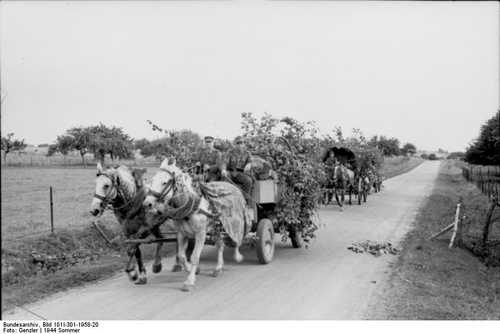
Horse power - German supply carts.
Horse-drawn German supply carts in Normandy, summer, 1944. Notwithstanding its reputation as a "mechanized army", Hitler's forces were chronically short of motor transport throughout the war. This forced them to organize their transport in a way that can be viewed, in a simplified sense, as a sort of pyramid, with railways at its apex, motor transport in the middle, and a very, very large base consisting of carts, drawn mainly (overwhelmingly) by horses. This created a huge problem because, at the time, European agriculture also depended almost totally on horses to draw wagons, pull ploughs and so on, in Germany as much as anywhere else. As early as late-1940, the Germans were "purchasing" large numbers of horses from the western occupied countries. It was always a tricky balance, how to satisfy the Army's limitless requirement for horses while, at the same time, avoiding a complete disruption of the agricultural economy, both in Germany and in occupied areas. Increasingly, the demands of the Army won out. The pacific air of this photo suggests that it was taken in a rear area, probably before "Overlord" and its advance (aerial) preparations had gotten into full swing. Slow-moving horse-drawn transport, which was effectively confined to roads and tracks, were a very soft target for Allied fighters and fighter-bombers, and many columns were shot up in the early stages, adding the additional handicap of mandatory night movement to the difficulties faced by the hapless transport troops. Best regards, JR.
This is a companion discussion topic for the original entry at https://www.ww2incolor.com/gallery/german-forces/53208/horse-power-german-supply-carts.
